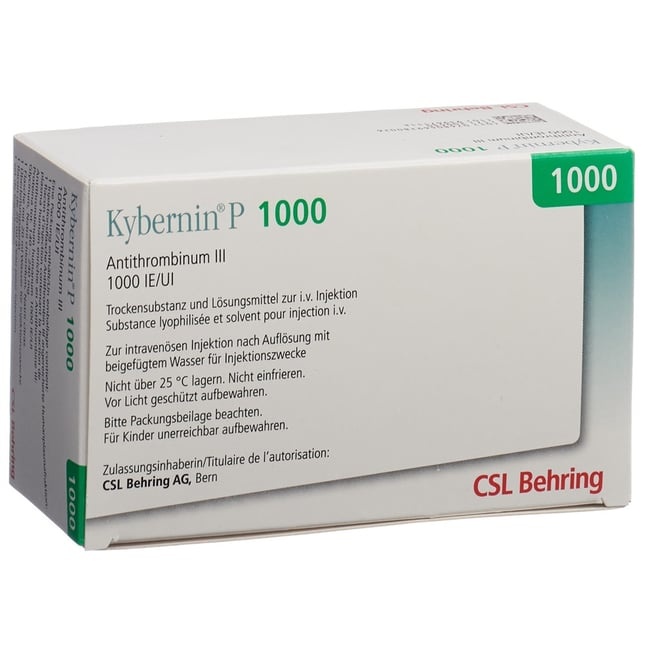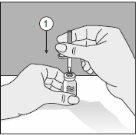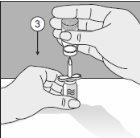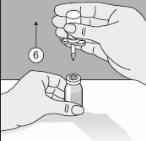

КІБЕРНІН П 1000 МО ПОРОШОК І РОЗЧИННИК ДЛЯ ПРИГОТУВАННЯ РОЗЧИНУ ДЛЯ ІН'ЄКЦІЙ АБО ІНФУЗІЙ


Інструкція із застосування КІБЕРНІН П 1000 МО ПОРОШОК І РОЗЧИННИК ДЛЯ ПРИГОТУВАННЯ РОЗЧИНУ ДЛЯ ІН'ЄКЦІЙ АБО ІНФУЗІЙ
Вступ
Опис: інформація для користувача
Kybernin P 1000 UI порошок і розчинник для ін'єкційного розчину та для перфузії.
Людський антитромбін III
Прочитайте уважно весь опис перед початком використання цього лікарського засобу,адже він містить важливу інформацію для вас.
- Збережіть цей опис, оскільки вам може знадобитися знову його прочитати.
- Якщо у вас виникли питання, проконсультуйтеся з вашим лікарем або фармацевтом.
- Цей лікарський засіб призначений лише вам, і його не слід давати іншим людям, навіть якщо вони мають相同ні симптоми, оскільки це може їм нашкодити.
- Якщо ви відчуваєте побічні ефекти, проконсультуйтеся з вашим лікарем або фармацевтом, навіть якщо це побічні ефекти, які не вказані в цьому описі. Див. розділ 4.
Зміст опису
- Що таке Kybernin P і для чого він використовується
- Що потрібно знати перед початком використання Kybernin P
- Як використовувати Kybernin P
- Можливі побічні ефекти
- Збереження Kybernin P
- Зміст упаковки та додаткова інформація
1. Що таке Kybernin P і для чого він використовується
Kybernin P є порошком і розчинником для ін'єкційного розчину та для перфузії.
Цей лікарський засіб належить до групи лікарських засобів, званих антитромботичними агентами.
Kybernin P використовується, якщо у вас є вроджений дефект антитромбіну, для профілактики утворення та розвитку тромбів у кровоносних судинах ваших ніг (глибока венозна тромбоз) або в інших судинах вашого тіла (тромбоемболія) під час операції або в період навколо пологів та у поєднанні з гепарином, якщо це показано.
Kybernin P також використовується, якщо у вас є набутий дефект антитромбіну.
2. Що потрібно знати перед початком використання Kybernin P
Не використовуйте Kybernin P:
Якщо ви алергічні на активну речовину або на одну з інших складових цього лікарського засобу (перелічених у розділі 6).
Попередження та застереження
Як і з будь-яким білковим продуктом для внутрішньовенної ін'єкції, можливі алергічні реакції. Потрібен тісний моніторинг та ретельне спостереження за пацієнтами для виявлення будь-яких симптомів під час періоду перфузії. Пацієнтів потрібно інформувати про перші ознаки алергічних реакцій, які включають шкірні висипи, які можуть перейти в загальну уртикарію, стиснення грудної клітки, труднощі з диханням, гіпотонію та анафілаксію. Якщо ці симптоми виникають після введення, необхідно звернутися до лікаря.
У разі шоку слід дотримуватися чинних рекомендацій щодо лікування.
Вірусна безпека
Коли вводяться лікарські засоби, отримані з людської крові або плазми, необхідно проводити певні заходи для уникнення передачі інфекцій пацієнтам. Такі заходи включають:
- Ретельний відбір донорів, щоб виключити тих, хто знаходиться в групі ризику бути носіями інфекційних захворювань,
- Аналіз специфічних маркерів інфекцій у індивідуальних донорських матеріалах та у сумішах плазми,
- Включення етапів у процесі виробництва для видалення/інактивації вірусів.
Незважаючи на це, коли вводяться лікарські засоби, отримані з людської крові або плазми, можливість передачі інфекційних агентів не можна повністю виключити. Це також стосується нових чи невідомих вірусів або інших типів інфекцій.
Захід, прийняті для забезпечення безпеки, вважаються ефективними щодо вірусів з оболонкою, таких як вірус імунодефіциту людини (ВІЛ), вірус гепатиту Б (ВГБ), вірус гепатиту С (ВГС), та для невірусних вірусів, таких як гепатит А (ВГА) та парвовірус Б19.
Ваш лікар може порекомендувати вам розглянути питання про вакцинацію проти гепатиту А та Б, якщо ви регулярно приймаєте продукти з антитромбіном, отриманим з плазми людини.
Високо рекомендується, щоб кожного разу, коли вводиться Kybernin P пацієнту, робився запис про назву лікарського засобу та номер партії, введеного пацієнту, щоб підтримувати зв'язок між пацієнтом та партією продукції.
Клінічний та біологічний моніторинг у разі спільного введення антитромбіну та гепарину:
- Для регулювання дози гепарину та уникнення надмірної гіпокоагуляції необхідно регулярно проводити контроль антикоагуляції (АППТ, а коли це доречно активність анти-ФХа), на коротких інтервалах та особливо в перші хвилини/години після початку введення антитромбіну.
- Визначення щоденного рівня антитромбіну з метою регулювання індивідуальної дози через ризик зниження рівня антитромбіну внаслідок тривалого лікування гепарином.
Використання Kybernin P з іншими лікарськими засобами
Гепарин: заміщення антитромбіну під час введення гепарину у терапевтичних дозах збільшує ризик кровотечі. Ефект антитромбіну значно посилюється гепарином. Період напіврозпаду антитромбіну може суттєво зменшитися через спільне лікування гепарином через прискорену мобілізацію антитромбіну. Тому спільне введення гепарину та антитромбіну пацієнту з підвищеним ризиком кровотечі повинно бути клінічно та біологічно моніторованим.
Повідомте вашого лікаря або фармацевта, якщо ви використовуєте, нещодавно використовували або можете використовувати будь-який інший лікарський засіб.
Вагітність, лактація та фертильність
Досвід щодо безпеки лікарських засобів антитромбіну людини для використання під час вагітності обмежений.
Безпека використання Kybernin P під час вагітності людини не встановлена в клінічних дослідженнях. Дослідження на тваринах недостатні для оцінки безпеки щодо репродукції, розвитку ембріона або плода, перебігу вагітності та післяпологового розвитку.
Немає негативного досвіду щодо лікування під час вагітності та лактації.
Тому Kybernin P повинен вводитися вагітним або годуючим жінкам з дефектом антитромбіну лише у випадках, коли це явно показано, враховуючи те, що вагітність збільшує ризик тромбоемболічних епізодів у цих пацієнтів.
Якщо ви вагітні або перебуваєте в період лактації, вважаєте, що можете бути вагітною або плануєте завагітніти, проконсультуйтеся з вашим лікарем або фармацевтом перед використанням цього лікарського засобу. Ваш лікар зважить можливий ризик для плода та повідомить вам, чи є лікування цим лікарським засобом доречним. Ваш лікар порекомендує це лікування лише у випадках, коли це явно показано.
Водіння транспортних засобів та використання машин
Немає жодних вказівок на те, що Kybernin P може впливати на здатність керувати транспортними засобами або обслуговувати машини.
Kybernin P містить натрій
Пацієнти з дієтою з низьким вмістом натрію повинні враховувати, що Kybernin P 1000 UI містить до 89,52 мг (3,894 ммоль) натрію на 1000 UI.
3. Як використовувати Kybernin P
Kybernin P є лікарським засобом для використання в лікарні, тому його введення здійснюватиметься в лікарні відповідним медичним персоналом.
Kybernin P вводиться шляхом підготовки розчину, який потім вводиться або перфундуватися внутрішньовенно повільно (максимально 4 мл/хв).
Слідуйте точно інструкціям щодо введення цього лікарського засобу, вказаним вашим лікарем або фармацевтом. У разі сумнівів проконсультуйтеся знову з вашим лікарем або фармацевтом.
Ваш лікар призначить, з якою частотою та на яких інтервалах повинен вводитися Kybernin P.
Ваш лікар призначить тривалість лікування Kybernin P.
Якщо ви використали більше Kybernin P, ніж потрібно:
Не повідомлялося про симптоми передозування з антитромбіном.
У разі передозування або випадкового введення зверніться до Токсикологічної служби. Телефон 91 562 04 20.
Якщо ви забули використати Kybernin P:
- Негайно проконсультуйтеся з вашим лікарем або фармацевтом.
- Не вводіть подвійну дозу для компенсації пропущених доз.
4. Можливі побічні ефекти
Як і всі лікарські засоби, цей лікарський засіб може спричиняти побічні ефекти, хоча не всі люди їх відчувають.
Наступні побічні реакції базуються на досвіді після реєстрації. У випадках, коли доступні дані, використовувалися наступні стандартні категорії частоти:
Дуже часто >1/10
Часто >1/100 до <1>
Нечасто ≥ 1/1000 до <1>
Рідко ≥ 1/10 000 до <1>
Дуже рідко <1>
Класифікація за органами та системами | Переважний термін | Частота |
Розлади імунної системи | Алергічна реакція/анafilактичні реакції, включаючи важку анафілаксію та шок. | Рідко |
Загальні розлади та в місці введення | Пірексія | Рідко |
Для інформації про вірусну безпеку див. «Попередження та застереження» у розділі 2 цього опису.
Повідомлення про побічні ефекти
Якщо ви відчуваєте будь-який тип побічного ефекту, проконсультуйтеся з вашим лікарем або фармацевтом, навіть якщо це побічні ефекти, які не вказані в цьому описі. Ви також можете повідомити про них безпосередньо через Систему фармакологічного моніторингу лікарських засобів для людини: https://www.notificaram.es. Повідомляючи про побічні ефекти, ви можете допомогти надати більше інформації про безпеку цього лікарського засобу.
5. Збереження Kybernin P
Тримайте цей лікарський засіб поза зоною видимості та досягнення дітей.
Не зберігають при температурі вище 25 °C. Не заморожувати.
Не використовуйте цей лікарський засіб після закінчення терміну придатності, вказаного на упаковці після EXP. Термін придатності є останнім днем місяця, який вказано.
Не використовуйте розчини, які є мутними або містять осади (відкладення/частинки).
Після реконституції фізико-хімічна стабільність була доведена протягом 8 годин при кімнатній температурі (макс. 25 °C). З мікробіологічної точки зору та оскільки Kybernin P не містить консервантів, реконституйований розчин повинен бути використаний негайно. Якщо це не можливо, не зберігайте більше 8 годин при кімнатній температурі (максимально 25 °C).
Видалення невикористаного лікарського засобу або відходів повинно здійснюватися згідно з місцевими нормативами.
Лікарські засоби не повинні викидати в каналізацію чи сміття. Спитайте вашого фармацевта, як позбутися упаковок та лікарських засобів, які вам більше не потрібні. Таким чином, ви допоможете захистити навколишнє середовище.
6. Зміст упаковки та додаткова інформація
Склад Kybernin P 1 000 UI
- Активна речовина - антитромбін III. Кожна ліофілізована ампула містить 1000 UI антитромбіну III. Реконституйований розчин містить приблизно 50 UI антитромбіну III/мл антитромбіну, отриманого з плазми людини, коли реконституйований з 20 мл води для ін'єкцій.
Потужність (UI) визначається за допомогою методу хромогенних субстратів згідно з Європейською фармакопеєю. Специфічна активність Kybernin P становить приблизно 5,3 UI/мг білка.
- Інші складові: гліцин, хлорид натрію, цитрат натрію, хлоридна кислота або гідроксид натрію (для регулювання pH) та вода для ін'єкцій.
Див. розділ 2 для інформації про окремі складові.
Вигляд продукції та зміст упаковки
Порошок та розчинник для ін'єкційного розчину та для перфузії.
Упаковка для продажу містить ампулу для ін'єкцій з скла типу II (за Фарм. Eur.), прозору та закриту гумовою пробкою, пластиковим диском та алюмінієвою кришкою, яка містить ліофілізований препарат, ампулу з 20 мл води для ін'єкцій (розчинник для підготовки розчину) та трансфузор.
Презентації:
Індивідуальна упаковка Kybernin P 1 000 UI:
1 ампула ліофілізату
1 ампула з 20 мл води для ін'єкцій
1 трансфузор
Клінічна упаковка Kybernin P 1 000 UI:
10 ампул ліофілізату
10 ампул з 20 мл води для ін'єкцій
10 трансфузорів
Можливо, що тільки деякі розміри упаковок будуть реалізовані.
Уповноважений на отримання дозволу на продаж та відповідальний за виробництво
Уповноважений на отримання дозволу на продаж
CSL Behring, S.A.
вул. Таррагона, 157, 18-й поверх
08014 Барселона - Іспанія
Відповідальний за виробництво
CSL Behring GmbH
вул. Еміля фон Берінга, 76
35041 Марбург - Німеччина
Дата останнього перегляду цього опису: листопад 2020
Детальна та актуальна інформація про цей лікарський засіб доступна на сайті Іспанського агентства лікарських засобів та медичних продуктів (AEMPS) http://www.aemps.gob.es
Ця інформація призначена лише для медичних працівників:
Дозування
При вроджених дефектах доза повинна бути індивідуалізована для кожного пацієнта, враховуючи сімейну історію щодо тромбоемболічних епізодів, клінічні фактори ризику пацієнта та лабораторні тести.
Дозування та тривалість терапії заміщення при набутому дефекті залежать від рівня антитромбіну в плазмі, наявності ознак підвищеної мобілізації, основного захворювання та тяжкості клінічної картини пацієнта. Доза та частота введення повинні базуватися завжди на клінічній ефективності та лабораторних тестах у кожному окремому випадку.
Кількість одиниць антитромбіну, введених пацієнту, виражається в Міжнародних одиницях (UI), у зв'язку зі стандартом Всесвітньої організації охорони здоров'я (ВООЗ), чинним для антитромбіну. Активність антитромбіну в плазмі виражається як відсоток (у зв'язку з нормальною людською плазмою) або в Міжнародних одиницях (у зв'язку з міжнародним стандартом для антитромбіну в плазмі).
Одна міжнародна одиниця (UI) активності антитромбіну еквівалентна кількості антитромбіну в 1 мл нормальної людської плазми. Розрахунок необхідної дози антитромбіну базується на емпіричному висновку, що 1 Міжнародна одиниця (UI) антитромбіну на кілограм маси тіла підвищує активність антитромбіну в плазмі приблизно на 1,5%.
Первоначальна доза визначається за наступною формулою:
Одиниці, необхідні = маса тіла [кг] x (100 – активність антитромбіну на момент початку лікування [%]) x 2/3
Активність антитромбіну, яку потрібно досягти спочатку, залежить від клінічного стану. Коли встановлено, що заміщення антитромбіном показане, доза повинна бути достатньою для досягнення бажаної активності антитромбіну та для підтримання ефективного рівня. Доза повинна визначатися та моніторитися згідно з лабораторними тестами на активність антитромбіну, які проводяться не менше двох разів на добу до стабілізації пацієнта, а потім один раз на добу, переважно безпосередньо перед наступною перфузією. Корекція дози повинна враховувати як ознаки підвищеної продукції антитромбіну згідно з лабораторними тестами, так і клінічну еволюцію. Активність антитромбіну повинна підтримуватися вище 80% протягом лікування, якщо клінічний стан не вказує на інший рівень ефективності.
Первоначальна доза зазвичай становить 30-50 UI/кг при вроджених дефектах.
Тому доза та частота введення, а також тривалість лікування повинні коригуватися згідно з біологічними даними та клінічною ситуацією.
Педіатричне населення:
Kybernin P не рекомендується для використання у дітей молодших 6 років через нестачу даних.
На основі клінічного досвіду не можна рекомендувати використання антитромбіну для лікування синдрому дистресу новонароджених (СДРН) у дітей, народжених передчасно.
Інструкції для правильного введення препарату
Загальні інструкції
Ліофілізований порошок повинен бути повністю реконституйований під умовами асептики з супутнім розчинником. Отримується прозорий або легенько опалесцентний розчин.
Підходящим розчинником є розчин альбуміну людини 5%. Для підготовки розбавлень до 1:5 можна використовувати також: рінгер-лактатний розчин, фізіологічний розчин, розчин глюкози 5% або полігеліну.
Не рекомендується використовувати гідроксієтиловий амідон як розчинник (для перфузії), оскільки спостерігалося зниження активності антитромбіну.
Цей лікарський засіб не повинен змішуватися з іншими лікарськими засобами в шприці/обладнанні для перфузії. Допамін, добутамін та фуросемід не повинні вводитися через той же венозний доступ.
Продукт повинен вводитися внутрішньовенно. Максимальна швидкість перфузії: 4 мл/хв.
Реконституція
Для правильного використання Transofix з подвійною голкою слід виконувати наступні кроки:

- Після зняття однієї з двох захисних кришок вставте відкриту голку перпендикулярно в гумову пробку флакона з розчинником.
- Зніміть захисну кришку з другої голки.

- Проколіть кришку флакона з продуктом цією голкою.
- Поверніть всю систему на 180°.
- Помістіть її так, щоб основа флакона з продуктом лежала на поверхні столу. Розчинник тепер тече до флакона з продуктом.

- Transofix з подвійною голкою разом з флаконом розчинника виймається з флакона продукту, а потім розчиняється Kybernin P. Реконституйований Kybernin P можна витягнути в шприц та введені.
- Країна реєстрації
- Діючі речовини
- Потрібен рецептТак
- Виробник
- СкладCITRATO DE SODIO (E-331) (40-100 mg mg), CLORURO DE SODIO (120-200 mg mg)
- Інформація є довідковою і не є медичною порадою. Перед прийомом будь-яких препаратів обов'язково проконсультуйтеся з лікарем. Oladoctor не несе відповідальності за медичні рішення, прийняті на основі цього контенту.
- Альтернативи до КІБЕРНІН П 1000 МО ПОРОШОК І РОЗЧИННИК ДЛЯ ПРИГОТУВАННЯ РОЗЧИНУ ДЛЯ ІН'ЄКЦІЙ АБО ІНФУЗІЙФорма випуску: РОЗЧИН ДЛЯ ІНФУЗІЙ, ЩО ВВОДИТЬСЯ ІН'ЄКЦІЙНО, 1000 ОД антитромбін III людиниДіючі речовини: antithrombin IIIВиробник: Octapharma S.A.Потрібен рецептФорма випуску: РОЗЧИН ДЛЯ ІНФУЗІЙ, ЩО ВВОДИТЬСЯ ІН'ЄКЦІЙНО, 500 ОД антитромбін III людиниДіючі речовини: antithrombin IIIВиробник: Octapharma S.A.Потрібен рецептФорма випуску: РОЗЧИН ДЛЯ ІН'ЄКЦІЙ, 500 ОД антитромбінуДіючі речовини: antithrombin IIIВиробник: Csl Behring S.A.Потрібен рецепт




